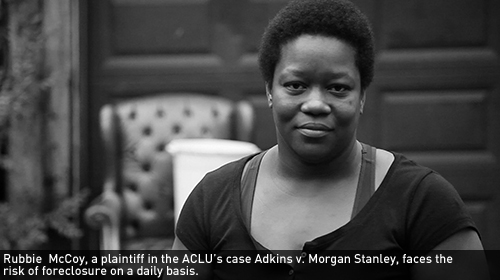
During our nation's prolonged economic downturn, most of us have been impacted by foreclosures, unemployment, or a significant loss of savings. These hardships, however, haven't fallen equally across the backs of all Americans – minorities have borne a disproportionate share of the burden. Minority families are during the Great Recession. And, since these households relied on home equity for a greater proportion of their household wealth, between whites and ethnic minorities. Discrimination, not neutral market forces, explains many of these disparities. Thus, the Consumer Financial Protection Bureau's (CFPB) recently issued rule is a welcome first step towards protecting the civil rights of all Americans, so that every individual can achieve the American dream of homeownership on a fair and level playing field.
The significance of the CFPB's rule comes into focus when you hear the story of ŔĎ°ÄĂĹżŞ˝±˝áąű client Rubbie McCoy. Rubbie, a single mother of four and a plaintiff in the ŔĎ°ÄĂĹżŞ˝±˝áąű's case Adkins v. Morgan Stanley, received a toxic loan from a subprime lender, which was immediately sold and packaged into a mortgage-backed security. Excessive fees and costs were imposed on Rubbie's loan, which significantly increased the total mortgage loan, and a prepayment penalty made it difficult to refinance. The lender even received a financial incentive to steer her into . Rubbie and her family now face the risk of foreclosure on a daily basis.
Rubbie's experience wasn't just unfair; it was a consequence of discriminatory practices spurred on from the highest echelons of Wall Street. The ŔĎ°ÄĂĹżŞ˝±˝áąű's challenge to these practices is based on one simple principle: Wall Street isn't above our nation's anti-discrimination laws. Fortunately, the effort to protect homeowners like Rubbie was bolstered by the CFPB's .
Many of Rubbie's predatory loan features – including excessive points and fees and prepayment penalties – will be limited and subject to stricter oversight and monitoring by the CFPB as the provisions of this rule go into effect in January 2014. While implementation of this rule will benefit all Americans, it is particularly important to African-American and Hispanic borrowers, who were disproportionately targeted for predatory loans doomed to result in foreclosure. (It is for this reason that the ŔĎ°ÄĂĹżŞ˝±˝áąű urged the CFPB to implement stronger protections against predatory lending in its rulemaking).
In order to understand the civil rights dimensions of predatory lending, consider the statistics. During the housing boom, . African Americans were with similar credit qualifications, down payment ratios, and residential property locations. Lest you think this phenomenon only impacted low-income borrowers, .
Much of the disparity in foreclosure rates stems from residential segregation, or refusing to lend in predominantly minority communities. During the housing boom, however, a new phenomenon – reverse redlining – emerged. Reverse redlining takes advantage of the absence of traditional credit institutions in communities of color by targeting them for loans that are .
Reverse redlining flourished during a ground-shift in the housing finance market. After generations of holding mortgage loans on their balance sheets, and cautiously making fixed-rate mortgage loans, risk-based pricing was introduced—leading to the growth of subprime loans. The , which were packaged as mortgage-backed securities. Mortgage brokers and loan officers often . And Wall Street had a seemingly bottomless desire for subprime loans to securitize, as .
CFPB's new rule is no panacea, and it does not help the many Americans who were victimized by discrimination and ended up losing their home. But it is a first step to better prevent and address predatory lending. When it goes into effect next year, lenders will be required to make an , based on objective and verifiable criteria and the assumption that the loan will be repaid in substantially equal payments (rather than qualifying the borrower based on the initial rate). The final rule also creates an incentive for lenders to make loans without layers of risk factors, by The for a "qualified mortgage" generally – with a few exceptions –exclude "no-doc" loans, made without verifying income or assets; loans with negative amortization or interest-only payments; loans with balloon payments; or loans with points and fees exceeding 3 percent of the total loan amount. Further, . Together, these new provisions will go a long way towards reducing predatory lending, and eradicating the kind of rampant discrimination that battered minority communities in recent years.
Learn more about housing discrimination and other civil liberty issues: Sign up for breaking news alerts, , and .

